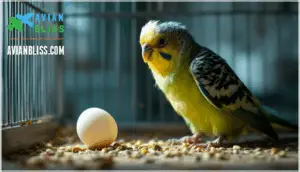This site is supported by our readers. We may earn a commission, at no cost to you, if you purchase through links.

When you understand what triggers this response, you gain control over it. The biology driving egg laying without a mate involves complex hormonal systems shaped by evolution, but the consequences matter: chronic egg laying depletes your bird’s calcium, energy, and health. Learning why this happens—and how to manage it—keeps your bird thriving.
Table Of Contents
- Key Takeaways
- Environmental Triggers of Egg Laying
- Biological Process of Egg Laying
- Recognizing and Managing Egg Binding
- Managing Unwanted Egg Laying
- Providing Support and Preventing Health Issues
- Frequently Asked Questions (FAQs)
- Can a female bird lay eggs without a mate?
- Why do birds lay eggs without a male present?
- Do birds need to mate to lay eggs?
- Why do birds mate without a mate?
- Why do hens lay eggs without a mate?
- Why do parrots lay eggs without a mate?
- Can a bird lay an egg without mating?
- Why do some birds lay unfertilized eggs?
- What should I do if my bird laid an egg without a mate?
- Can females lay eggs without mating?
- Conclusion
Key Takeaways
- Female birds lay unfertilized eggs through a biological process called oviposition, which is triggered by environmental cues like artificial light, temperature, and social stimulation rather than requiring a mate.
- Chronic egg laying depletes your bird’s calcium and energy reserves significantly, increasing risks of egg binding, soft-shelled eggs, and reproductive infections that can become life-threatening.
- You can reduce unwanted egg laying by adjusting light exposure to 12-14 hours of darkness daily, removing mirrors and nesting materials, limiting back-and-wing petting, and providing proper calcium-rich nutrition.
- When environmental changes don’t stop excessive laying, medical options like hormonal therapy (deslorelin implants) or surgical removal of the oviduct offer lasting solutions, though surgery carries 5-12% mortality risk and costs $500-$2,000.
Environmental Triggers of Egg Laying
Your bird’s body doesn’t know the difference between a cozy nest and a cardboard box—it just knows it’s time to lay eggs. The environment you create plays a surprisingly powerful role in triggering reproductive actions, even without a male around.
Let’s look at the specific factors that can flip the switch on egg production.
Photoperiod and Day Length
Every spring, when daylight stretches a little longer, birds’ bodies notice—and that extra hour of sunshine can flip a hormonal switch that sets egg production in motion. This photoperiod effect works through circadian rhythm regulation, where light intensity affects melatonin production in your bird’s brain. Environmental cues like day length trigger hormonal changes that signal breeding season, even in captivity where artificial lighting disrupts natural cycles.
Here’s how photoperiod influences seasonal egg laying:
- Light receptors in the brain detect increasing day length and suppress melatonin
- Hormonal cascades stimulate reproductive organs when days exceed 12-14 hours
- Artificial lighting mimics spring conditions year-round, confusing natural breeding cycles
- Environmental triggers override instinctive timing, causing out-of-season egg production
- Circadian rhythm disruption from inconsistent light exposure intensifies the response
Artificial Light Exposure
Your lamp-lit living room might be sabotaging your bird’s hormones. Constant artificial light tricks their brain into thinking it’s always breeding season, which can trigger egg production even without a mate.
Light intensity and exposure duration matter because prolonged artificial light suppresses melatonin, disrupting circadian rhythms that regulate reproduction. This spectral composition mimics extended photoperiods, creating environmental triggers that cause unwanted egg laying in your captive environment year-round.
Toys and Mirrors as Stimuli
While artificial light can mess with your bird’s internal clock, the shiny mirror hanging in their cage might be playing matchmaker with an invisible friend. Mirror stimulation triggers redirected action as your bird bonds with its reflection, creating sexual frustration that can spark egg production. These environmental triggers aren’t just about mirrors—here’s what drives enrichment strategies gone wrong:
- Mirrors create mirror-induced aggression and courtship actions in many avian species.
- Certain toy preferences, like bells or stuffed animals, mimic mate presence.
- Environmental stimulation from these objects confuses natural breeding signals.
- Problems arise when birds can’t distinguish toys from actual companions.
Remove mirrors and rotate toys frequently to prevent unwanted egg laying.
Vocalizations and Social Interaction
Just as toys and mirrors trick your bird into thinking it has company, the sounds filling your home—whether from another bird across the room or even your own voice—can flip the same reproductive switch.
Vocalizations serve multiple purposes in avian reproduction, including mate attraction and establishing social hierarchy. When your bird hears chirps, songs, or even human speech patterns, these bonding cues can stimulate hormonal changes that lead to unfertilized eggs through parthenogenesis—even without actual social interaction with a potential mate.
Petting and Physical Contact
You mightn’t realize it, but the way you stroke your bird’s feathers can send a clear message: "Let’s start a family." Human interaction, particularly petting triggers along your pet bird’s back, wings, or vent area, mimics mating activity and causes sexual stimulation. This approach activates hormonal pathways that drive egg laying and parthenogenesis—the production of unfertilized eggs without fertilization.
To prevent unwanted reproductive activity and shifts in your pet birds, adjust your approach:
- Restrict physical contact to head and neck areas only
- Keep petting sessions brief (under 10 minutes daily)
- Avoid stroking back, wings, tail, or underside regions
- Watch for signs like tail lifting or crouching postures that indicate overstimulation
Biological Process of Egg Laying
When you understand the environmental triggers that can spark egg laying, you’re ready to look at what’s actually happening inside your bird’s body.
Egg production is a complex biological process driven by hormones, energy demands, and evolutionary programming. Let’s break down how and why this process unfolds, even without a mate present.
Egg Laying as a Biological Response
When a female bird’s body detects favorable conditions—abundant food, longer daylight, or the right temperature—her reproductive system kicks into gear automatically, triggering egg production whether or not a male is anywhere in sight. This isn’t a deliberate decision but a biological response hardwired by evolution.
Hormonal regulation drives oviposition—the process of laying eggs—regardless of fertilization. Think of it as your bird’s body preparing for opportunities that mightn’t even exist yet, producing unfertilized eggs through hormonal influence alone.
Resource Allocation for Survival and Reproduction
Every egg a bird produces demands resources her body could otherwise use to fuel daily survival—a constant trade-off between investing in offspring and keeping herself healthy enough to see another season. Calcium depletion hits particularly hard, draining reserves needed for bone strength and muscle function.
This nutrient prioritization creates reproductive tradeoffs that shape her survival strategy. Whether producing unfertilized eggs through parthenogenesis or standard oviposition, energy expenditure remains substantial, forcing her body to choose between immediate survival and future reproduction.
Energy Costs of Egg Laying
Producing eggs without mating isn’t just physically demanding—it’s a metabolic sprint your bird’s body wasn’t designed to run repeatedly. Research shows laying females experience a 22.4% increase in resting metabolic rate during follicle development, placing enormous strain on resource allocation systems and creating nutritional deficiencies if dietary energy falls short. This increase highlights the high metabolic cost of egg production.
Understanding this energy expenditure helps explain why proper nutrition matters so desperately:
- Her body burns through calcium reserves faster than a furnace through kindling, weakening bones with each unfertilized egg
- Metabolic rate spikes force her system to cannibalize fat stores, leaving her vulnerable to illness and exhaustion
- Dietary needs skyrocket beyond normal maintenance, yet captive birds rarely receive adequate supplementation to match this demand
- The hidden environmental impact compounds when commercial poultry economics prioritize production over individual bird welfare and long-term health
Natural Breeding Seasons and Environmental Cues
In the wild, most birds time their egg production to sync with spring’s longer days and abundant food supplies—a biological strategy honed over millions of years to make chick survival as great as possible. This seasonal breeding pattern relies on environmental cues your bird’s body still recognizes:
- Increasing photoperiod triggers hormonal cascades in avian endocrinology
- Temperature shifts signal ideal nesting conduct timing
- Food abundance assures energy for reproduction
- Migration patterns align with breeding territory availability
- Climate impact determines regional breeding windows
These natural breeding cycles get scrambled in captivity, where constant lighting and stable conditions confuse your bird’s internal breeding clock.
Captivity and Disrupted Breeding Cycles
Captivity complicates your bird’s evolutionary programming, turning a well-timed biological calendar into a year-round breeding free-for-all. Artificial environments eliminate the natural photoperiod shifts that regulate reproduction, while constant temperatures and unlimited food trick your bird’s hormones into perpetual breeding mode. These captivity effects create shifts in conduct that lead to excessive egg laying and serious health implications.
| Natural Environment | Captive Environment | Result |
|---|---|---|
| Seasonal light cycles | Artificial 12+ hour lighting | Continuous hormone stimulation |
| Variable temperatures | Stable warmth | Year-round breeding readiness |
| Limited nesting sites | Cozy cage corners everywhere | Constant egg production triggers |
This breeding disruption explains why preventing excessive egg laying requires deliberately recreating natural environmental triggers your bird would experience in the wild.
Recognizing and Managing Egg Binding
Egg binding is one of the most serious complications of frequent egg laying, and recognizing it early can be the difference between life and death for your bird. The condition occurs when an egg becomes stuck in the reproductive tract, leading to a cascade of potentially fatal health problems.
Understanding the warning signs and taking preventive steps will help you protect your bird from this dangerous situation.
Symptoms of Egg Binding
Egg binding sneaks up fast, and spotting the warning signs early can save your bird’s life. Watch for limb weakness, especially in the rear legs, or strained breathing that seems labored. Your bird might lose her appetite entirely or develop a swollen abdomen.
Paralysis signs and shock symptoms like lethargy demand immediate veterinary attention. Recognizing these dystocia management indicators helps you act quickly, preventing egg binding complications before they become life-threatening.
Causes of Egg Binding
Age factors play a surprisingly large role—older birds face three to four times higher rates of egg binding, with first-timers also at elevated risk. Nutritional deficiencies, especially calcium deficiency, severely weaken muscle contractions needed to expel eggs. Environmental stressors like temperature drops or sudden changes trigger binding in about a quarter of cases. Add in anatomical issues like malformed eggs or oviduct infections, plus hormonal imbalances from disrupted light cycles, and you’ve got a perfect storm requiring veterinary attention for proper dystocia management. Birds with inadequate calcium intake are particularly susceptible to egg binding issues.
Key contributors include:
- Calcium and vitamin shortages that compromise reproductive muscle function
- Obesity and all-seed diets creating structural complications during egg passage
- Restricted movement in small cages limiting physical conditioning for egg laying
Preventing Egg Binding Through Diet and Nutrition
Once you understand what causes egg binding, the next step is making sure your bird’s diet actually prevents it from happening in the first place. Proper nutrition addresses calcium deficiency head-on while supporting overall reproductive health. Focus on three critical areas:
- Calcium Sources – Dark leafy greens, cuttlebone, and mineral blocks provide essential calcium for strong eggshells.
- Vitamin D and Protein Balance – Natural sunlight or UVB lighting activates calcium absorption while balanced protein prevents overproduction.
- Fiber Intake and Hydration Importance – Fresh vegetables and constant water access support healthy digestion and egg passage.
This nutritional support is your first line of defense in preventing egg binding.
Calcium Supplementation and Egg Binding Prevention
Supplementing with calcium goes beyond just providing sources—it requires knowing how much your bird actually needs and when to add extra support. Laying birds need roughly twice the calcium of non-layers, making proper nutrition critical for preventing egg binding.
Watch for soft or thin eggshells—they signal calcium deficiency before serious problems develop. Cuttlebone and calcium-fortified pellets work well, but dosing powdered supplements requires veterinary guidance to avoid overdoing it.
Pair calcium supplementation with adequate hydration, as water helps your bird absorb minerals and pass eggs safely.
Veterinary Attention for Egg Binding
Spotting egg binding early can mean the difference between a quick fix and a life-threatening emergency, so knowing when to call your avian vet is important. Your avian veterinarian will use diagnosis methods like physical exams and X-rays to confirm egg binding and determine the best approach.
Emergency treatment options include:
- Calcium injections and fluid therapy to strengthen contractions
- Manual manipulation or surgical extraction when the egg won’t pass naturally
- Post-operative care with antibiotics and pain management to prevent infection
Long-term prognosis depends on how quickly you sought veterinary care and whether complications developed during this medical emergency.
Managing Unwanted Egg Laying
If your bird keeps laying eggs without a mate, you’ll want to take action to protect her health. The good news is that you have several options, from simple environmental tweaks to more involved medical interventions.
Let’s walk through the strategies that can help reduce or stop unwanted egg production.
Conservative Measures for Reducing Egg Laying
If your bird’s treating every day like spring breeding season, you’re not alone—and there are practical ways to dial back the hormonal overdrive without medication or surgery.
Start with conservative measures like relocating the cage to reduce nesting urges, cutting light exposure to discourage hormonal influences on birds, and removing mirrors or toys that trigger courtship actions.
Limit petting along the back and wings, and consider temporary social isolation to minimize environmental factors affecting birds and unfertilized eggs production.
Adjusting Photoperiod and Environmental Cues
One of the most effective ways to hit the brakes on unwanted egg production is by manipulating your bird’s exposure to light and changing up the surroundings. Light cycle manipulation works by providing 12-14 hours of darkness, mimicking winter conditions that naturally suppress breeding hormones.
Reducing stimulation through nesting site removal—like eliminating cozy corners or fabric—helps discourage maternal instincts. Relocate cage lighting away from windows with extended day length, and remove mirrors or toys that trigger courtship.
This behavioral modification through environmental enrichment and reduced artificial lighting helps reset your bird’s internal breeding clock.
Hormonal Therapy and Advanced Measures
When environmental changes don’t stop chronic laying, hormonal therapy offers a medical intervention. GnRH agonists like Lupron (leuprolide acetate) and deslorelin implants work by down-regulating reproductive hormones—basically pausing your bird’s breeding cycle.
Deslorelin efficacy extends four to eight months per implant, while Leuprolide safety profiles show minimal side effects during short-term use. However, therapy limitations include potential weight loss and diminishing effectiveness with repeated doses.
Calcium balance remains critical throughout treatment, as hormonal medication helps prevent depletion from relentless egg production.
Salpingectomy and Surgical Options
When hormones and habitat tweaks don’t resolve the problem, surgical removal of the oviduct—called a salpingectomy—offers a permanent solution. Your avian vet may recommend this procedure when chronic laying threatens your bird’s life.
Surgical intervention gets to the root cause by removing the reproductive tract:
- Salpingectomy Risks: Anesthesia complications and infection require careful consideration
- Recovery Timeline: Expect 2-3 weeks of restricted activity and close monitoring
- Post-Op Care: Pain management, antibiotics, and cage rest are essential for healing
Ovariectomy options, which remove both ovaries and oviduct, provide another surgical alternative.
Weighing The Risks and Benefits of Surgical Intervention
Surgery isn’t something to rush into—complications occur in 7% to 25% of cases, and mortality rates hover between 5% and 12%. You’ll need to weigh these risks against the benefits: successful salpingectomy stops egg production in 90% to 100% of birds. Anesthetic risk climbs to 30% for birds in poor health, and you’re looking at $500 to $2,000 in surgical costs.
| Factor | Consideration |
|---|---|
| Surgical Complications | 7% to 25% depending on species and approach |
| Mortality Rates | 5% to 12% average, higher in smaller birds |
| Success Rates | 90% to 100% when oviduct fully removed |
| Surgical Costs | $500 to $2,000 including anesthesia and care |
Your avian vet will assess whether your bird’s reproductive health warrants surgical intervention or if hormonal therapy and sophisticated measures remain viable alternatives for managing unwanted egg laying.
Providing Support and Preventing Health Issues
Once you’ve reduced egg-laying triggers, your next step is supporting your bird’s overall health during this challenging period.
The following strategies help you prevent complications like calcium deficiency, egg binding, and reproductive infections.
Let’s look at the specific ways you can keep your bird healthy and comfortable.
Removing Eggs and Discouraging Further Laying
Removing eggs isn’t cruel—it’s actually one of the simplest ways to pump the brakes on your bird’s relentless laying cycle. Swift egg removal timing signals to her body that reproduction isn’t working, naturally discouraging unwanted egg laying.
Pair this with nesting site removal and behavioral redirection through environmental enrichment:
- Remove mirrors, toys, and cozy corners that trigger nesting instincts
- Introduce foraging puzzles as deterrent strategies
- Minimize petting that stimulates parthenogenesis responses
These tactics redirect her energy away from producing unfertilized eggs.
Providing Adequate Hydration and Nutrition
Proper hydration and nutrition aren’t just helpful—they’re your bird’s lifeline when she’s cycling through egg production. Constant laying depletes calcium and energy reserves, so you’ll need to provide fresh water daily and a balanced diet rich in calcium sources.
Focus on these essentials:
- Prime hydration: Fresh water changed daily prevents dehydration during reproductive stress
- Balanced diet: Include leafy greens, legumes, and fortified pellets to combat nutritional deficiencies
- Calcium supplementation: Cuttlebone or calcium powder prevents softshelled eggs and egg peritonitis
Supplement strategies should address her increased metabolic demands during active egg production cycles.
Monitoring for Signs of Stress and Anxiety
Your bird’s emotional state matters just as much as her physical health, so watch for signs that stress or anxiety might be taking hold during her egg-laying cycle. Shifts in conduct like feather plucking, excessive vocalization, appetite loss, or social isolation often indicate elevated stress levels.
These behavioral indicators signal that your bird’s reproductive demands are taxing her mentally. Address stress triggers by providing quiet spaces, varying enrichment, and reducing interaction during active laying.
Managing egg laying successfully means monitoring both physical and emotional wellbeing.
Preventing Soft-Shelled Eggs and Eggperitonitis
Beyond behavioral stress, nutritional deficiencies pose serious reproductive threats. Soft-shelled eggs signal calcium depletion, while eggperitonitis—an infection of the abdominal cavity—can prove fatal.
Maintain consistent coop temperatures between 18–24°C to support proper shell formation. Guarantee daily access to fresh water, as dehydration increases soft-shelled egg rates by 35%. Supply balanced feed containing 3.5–4.0% calcium and adequate Vitamin D3 for absorption.
These measures reduce soft-shelled egg prevalence by 60% and lower eggperitonitis incidence considerably through proper flock management and water quality maintenance.
Ensuring Proper Nutrition and Calcium Supplementation
Calcium isn’t just another nutrient for your bird—it’s the backbone of everything from strong eggshells to healthy bones, and getting it right can mean the difference between a thriving bird and one facing serious reproductive complications. Without adequate dietary calcium and vitamin D3, your bird becomes vulnerable to egg binding, soft-shelled eggs, and egg peritonitis.
Offer cuttlebone, leafy greens like kale, and calcium-fortified pellets daily. Make sure fresh water is constantly accessible, as dehydration impairs shell formation.
Work with an avian veterinarian to tailor supplementation to your bird’s specific needs and monitor calcium levels regularly.
Frequently Asked Questions (FAQs)
Can a female bird lay eggs without a mate?
Yes, female birds can lay unfertilized eggs without a mate. This reproductive capability, called oviposition, occurs when hormonal triggers activate egg production regardless of mating status.
Environmental factors like photoperiod, artificial lighting, and social stimulation can prompt laying, making parthenogenesis a natural biological response in many species.
Why do birds lay eggs without a male present?
Female birds lay unfertilized eggs through a process called oviposition, triggered by hormonal imbalances and environmental factors like artificial lighting and photoperiod changes. This biological response occurs regardless of mating, as environmental cues stimulate egg production.
Repeated unfertilized egg laying risks calcium deficiency and reproductive complications in captive birds.
Do birds need to mate to lay eggs?
Surprisingly, no—birds don’t need a mate to lay eggs. Female birds produce unfertilized eggs via hormonal influence and environmental cues, independent of fertilization necessity.
However, frequent laying carries serious health implications, including calcium deficiency and egg binding, making parthenogenesis a survival strategy rather than routine reproduction.
Why do birds mate without a mate?
Birds lay eggs without mates through oviposition, a biological process triggered by hormonal shifts and environmental cues like photoperiod changes. This unfertilized egg-laying represents an adaptive strategy, though it carries health implications including calcium deficiency and egg binding risks requiring veterinary management.
Why do hens lay eggs without a mate?
Hens lay unfertilized eggs through oviposition, a natural biological process triggered by hormonal influence independent of mating. Environmental cues like photoperiod and artificial lighting stimulate egg production, while calcium depletion from laying frequency affects egg quality and bird health.
Why do parrots lay eggs without a mate?
Like a switch flipped in captivity, parrots lay unfertilized eggs due to hormonal imbalance triggered by environmental cues—artificial lighting, mirrors, and excessive petting stimulate oviposition.
Dietary needs for calcium deficiency prevention and shifts in conduct signal reproductive dysfunction, requiring avian vet consultation to manage egg-laying cycles.
Can a bird lay an egg without mating?
Absolutely. Avian oviposition, or egg laying, occurs independently of mating through hormonal triggers activated by environmental cues like artificial light and nesting materials. These stimuli prompt unfertilized egg production—a natural reproductive response called parthenogenesis in some species.
Without a mate, laid eggs remain unfertilized, presenting significant health risks including calcium deficiency and egg binding.
Why do some birds lay unfertilized eggs?
When environmental cues trigger hormonal shifts, unfertilized egg-laying begins through oviposition—independent of mating. Photoperiod changes, artificial lighting, and social stimuli activate reproductive hormones, initiating the egg-laying process.
Genetic predisposition makes certain birds susceptible to calcium depletion during avian reproduction cycles.
What should I do if my bird laid an egg without a mate?
When your pet bird lays an unfertilized egg, first reduce artificial light exposure to shorten her daylight hours. Remove nesting materials, toys, and mirrors that trigger egg-laying actions. Avoid excessive petting, which can stimulate hormone production.
Provide calcium-rich foods and fresh water daily. Allow minimal egg-sitting time, then gently remove the egg.
Consult an avian veterinarian if egg-laying persists, as chronic production risks calcium deficiency, egg binding, and reproductive tract problems.
Can females lay eggs without mating?
Egg-laying without fertilization occurs through a process called oviposition, triggered by hormonal shifts rather than mating. Longer daylight hours, artificial lighting, or environmental stress stimulate a female bird’s ovaries to produce unfertilized eggs—a natural biological response. This process doesn’t require a male to be present.
However, frequent laying carries health risks, such as calcium deficiency and egg binding, making proper nutrition and veterinary monitoring essential.
Conclusion
Your bird’s actions bypass biology’s basic requirement: a mate. When you comprehend why birds lay eggs without a mate—through photoperiods, physical contact, and environmental cues—you can carefully control these conditions.
Calcium depletion, exhaustion, and egg binding threaten your feathered friend’s future. Adjusting artificial light, removing triggering toys, and providing proper nutrition prevent these problems.
Ultimately, understanding your bird’s reproductive response transforms you from a puzzled pet owner into a proactive protector of its health and longevity.
- https://www.animalhouseofchicago.com/news/birds-unwanted-eggs
- https://birdline.co.uk/diet-linked-hormonal-behaviour-in-parrots/
- https://vcahospitals.com/know-your-pet/chronic-egg-laying-in-birds
- https://www.frontiersin.org/articles/10.3389/fendo.2019.00757/full
- https://birdswave.com/do-all-birds-lay-unfertilized-eggs/











